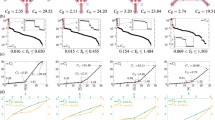Abstract
Orbital relaxation is treated as one of the reasons for shortening of chemical bonds with respect to the sum of the covalent radii of interacting atoms. The C-O, Si-O, Si-C, Si-H, Si-F, and Si-Cl bond lengths in organic and inorganic silicon compounds and of E-H and E-F bonds in diatomic hydrides and absolute-valent fluorides (E is a second-period element) are considered in terms of a simple empirical model of orbital relaxation. In all cases under study, orbital relaxation is an important factor affecting the length of the chemical bond.
Similar content being viewed by others
References
A. I. Ermakov, “Orbital relaxation, electronic structure, and properties of some classes of heterogeneous compounds,” Abstract of Doctoral Dissertation, Russian Chemical Technological University, Moscow (1993), p. 433.
A. I. Ennakov, “Orbital relaxation, electronic structure, and properties of some classes of heterogeneous compounds,” Abstract of Doctoral Dissertation, Russian Chemical Technological University, Moscow (1993), p. 32.
S. S. Batsanov,Structural Refractometry [in Russian], Vysshaya Shkola, Moscow (1976).
O. P. Charkin,Stability and Structure of Gaseous Inorganic Molecules, Radicals, and Ions [in Russian], Nauka, Moscow (1980).
A. I. Ermakov, “Investigation and analysis of cyclic heteroatomic silicon-containing compounds,” Chemical Sciences Candidate’s Dissertation, Moscow (1975), p. 182.
A. I. Ermakov,Zh. Strukt. Khim.,32, No. 4, 3–10 (1991).
V. A. Naumov and O. N. Kataeva,Molecular Structure of Oxygen and Sulfur Organic Compounds in the Gas Phase [in Russian], Nauka, Moscow (1990), p. 192.
I. Hargittai,Structure of Gaseous Sulfur Compounds [Russian translation], Center for Scientific and Technical Translations, No. D-05827, Moscow (1982), p. 411.
A. F. Skryshevskii, V. P. Klochkov, and Yu. V. Pasechnik,Zh. Strukt. Khim.,2, No. 2, 140–146 (1961).
M. Yokoi,Bull. Chem. Soc. Jpn.,30, No. 1, 100–109 (1957).
B. Czákvári, Z. Wagner, P. Gömöry, et al.,J. Organomet. Chem.,107, No. 3, 287–294 (1976).
M. J. Barrow, E. A. V. Ebsworth, and M. M. Harding,Acta Crystallogr.,B35, No. 9, 2093–2099 (1979).
A. Almenningen et al.,Acta Chem. Scand.,22, No. 9, 2455–2460 (1963).
W. Airey et al.,Trans. Faraday Soc.,77, No. 3, 551–556 (1970).
A. I. Gusev et al.,Zh. Strukt. Khim.,17, No. 5, 944–945 (1976).
C. Glidwell and D. C. Lues,Acta Crystallogr.,B34, No. 1, 124–128 (1978).
C. Glidwell and D. C. Lues,J. Organomet. Chem.,212, No. 3, 291–300 (1981).
A. I. Gusev et al.,Zh. Strukt. Khim.,24, No. 3, 178–179 (1983).
V. E. Shklover et al.,Dokl. Akad. Nauk SSSR,253, No. 2, 341–345 (1980).
D. W. Rankin and H. E. Robertson,J. Chem. Soc., Dalton Trans., No. 2, 265–269 (1983).
Q. Shen,J. Mol. Struct.,102, Nos. 3–4, 325–332 (1983).
V. E. Shklover et al.,Zh. Strukt. Khim.,26, No. 2, 125–133 (1985).
O’Keeffe et al.,Acta Crystallogr.,B34, No. 1, 27–32 (1978).
V. A. Ponomarenko and M. A. Ignatenko,Chemistry of Fluorine- and Silicon-Containing Organic Compounds [in Russian], Nauka, Moscow (1979), p. 191.
E. A. Zharikova, “Electronic structure and molecular properties of haloalkylchlorosilanes and their functional derivatives,” Chemical Sciences Candidate’s Dissertation, Moscow (1987), p. 179.
V. Typke, M. Dakkouri, and M. Sciele,Z. Naturforsch.,A35, No. 12, 1402–1407 (1980).
H. G. Kraft, B. Haas, and W. Zeil,ibid.,A34, No. 12, 1458–1462 (1979).
J. Goubea, F. Hauschke, and A. Ruoff,Z. Anorg. Allg. Chem.,366, Nos. 3–4, 113–120 (1969).
C. G. Pitt,Chem. Commun., No. 15, 816–818 (1971).
R. W. Davis, A. G. Robiette, and M. C. L. Gerry,J. Mol. Spectrosc,83, No. 1, 185–201 (1980).
é. Ya. Lukevitz, O. A. Pudova, and R. Ya. Sturkovich,Molecular Structure of Organosilicon Compounds [in Russian], Zinatne, Riga (1988).
Chemist’s Handbook [in Russian], Vol. 1 (1966), pp. 325–384.
Author information
Authors and Affiliations
Additional information
Translated fromZhumal Struktumoi Khimii, Vol. 38, No. 3, pp. 438–446, May–June, 1997.
Rights and permissions
About this article
Cite this article
Ermakov, A.I., Ponomarev, V.S., Makrushin, N.A. et al. Empirical model of orbital relaxation and interatomic distances in molecules with polar chemical bonds. J Struct Chem 38, 358–365 (1997). https://doi.org/10.1007/BF02763599
Received:
Issue Date:
DOI: https://doi.org/10.1007/BF02763599




